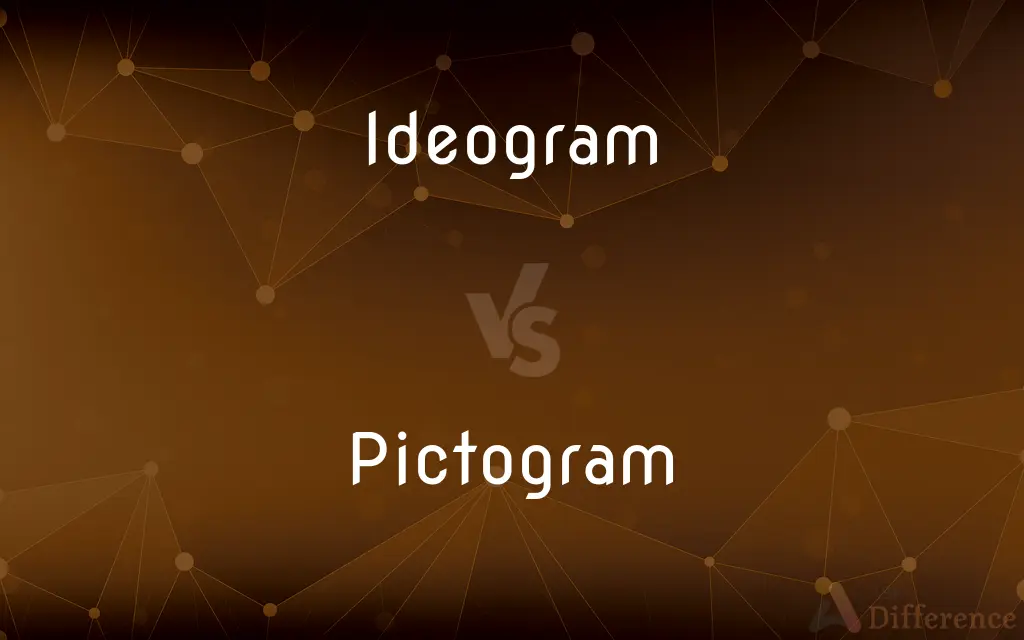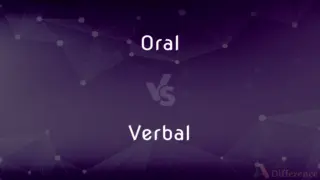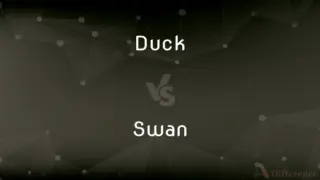Ideogram vs. Pictogram — What's the Difference?
By Tayyaba Rehman — Updated on October 17, 2023
Ideograms convey ideas through symbols, while pictograms represent objects or activities using pictures.

Difference Between Ideogram and Pictogram
Table of Contents
ADVERTISEMENT
Key Differences
An Ideogram is a graphic symbol that represents an idea or concept. A Pictogram, on the other hand, is a graphical representation that depicts an object or activity using a pictorial illustration. The essence of an Ideogram is its ability to convey abstract concepts that may not necessarily have a direct pictorial representation. In contrast, a Pictogram typically illustrates straightforward entities, often easily recognized by sight.
Both Ideogram and Pictogram are essential in visual communication; however, ideograms lean more towards abstract representation, while pictograms are generally more literal. This distinction is vital in understanding the evolution of written language, where Ideograms evolved into complex writing systems like Chinese characters, while Pictograms have largely remained within the realm of simplistic graphical representation.
To sum up, an Ideogram encapsulates an idea using a symbol, while a Pictogram uses an image to depict an object or action directly.
Comparison Chart
Nature
Represents an idea or concept.
Represents an object or activity.
Complexity
Can be abstract, capturing complex ideas.
Generally straightforward and literal.
ADVERTISEMENT
Usage in Writing Systems
Forms the basis of logographic writing systems like Chinese characters.
Seldom used as a comprehensive writing system.
Evolution Over Time
Evolves to represent a broad range of ideas.
Stays relatively direct in its representation.
Examples
Chinese characters, some Egyptian hieroglyphs.
Road signs, restroom symbols.
Compare with Definitions
Ideogram
A symbol that represents an idea without using specific words.
The '&' is an ideogram for and.
Pictogram
A graphic symbol representing an object or activity by illustration.
The picture of a phone on a sign is a pictogram indicating a telephone booth.
Ideogram
A character in a writing system, representing a thing or concept.
Chinese characters are often ideograms.
Pictogram
A simple image representing a specific thing or action.
A drawing of a cup on a coffee machine is a pictogram.
Ideogram
A graphic sign representing a complex idea or series of ideas.
The infinity symbol is an ideogram representing the idea of endlessness.
Pictogram
A universal symbol that can be understood regardless of language or culture.
A red circle with a diagonal line through it is a pictogram for no or not allowed.
Ideogram
A sign or symbol used in a system of writing to represent a whole word or phrase.
In mathematics, the '=' ideogram means equals.
Pictogram
A drawing used as a shorthand or substitute for a word or phrase.
Airports use pictograms to indicate services like restrooms or baggage claim.
Ideogram
A representation of a concept through symbols rather than literal depiction.
The peace sign is an ideogram that transcends language barriers.
Pictogram
An image that conveys its meaning through its pictorial resemblance to a physical object.
A skull and crossbones pictogram often means danger or poison.
Ideogram
An ideogram or ideograph (from Greek ἰδέα idéa "idea" and γράφω gráphō "to write") is a graphic symbol that represents an idea or concept, independent of any particular language, and specific words or phrases. Some ideograms are comprehensible only by familiarity with prior convention; others convey their meaning through pictorial resemblance to a physical object, and thus may also be referred to as pictograms.
Pictogram
A pictogram, also called a pictogramme, pictograph, or simply picto, and in computer usage an icon, is a graphic symbol that conveys its meaning through its pictorial resemblance to a physical object. Pictographs are often used in writing and graphic systems in which the characters are to a considerable extent pictorial in appearance.
Ideogram
A character or symbol representing an idea or a thing without expressing the pronunciation of a particular word or words for it, as in the traffic sign commonly used for "no parking" or "parking prohibited." Also called ideograph.
Pictogram
See pictograph.
Ideogram
See logogram.
Pictogram
A picture that represents a word or an idea by illustration.
Ideogram
A graphic symbol, such as &, $, or @.
Ideogram
A picture or symbol which represents the idea of something without indicating the sequence of sounds used to pronounce it. Examples include digits, traffic signs, and graphic symbols such as @.
Ideogram
An original, pictorial element of writing; a kind of hieroglyph expressing no sound, but only an idea.
Ideograms may be defined to be pictures intended to represent either things or thoughts.
You might even have a history without language written or spoken, by means of ideograms and gesture.
Ideogram
A symbol used for convenience, or for abbreviation; as, 1, 2, 3, +, -, , $, , etc.
Ideogram
A phonetic symbol; a letter.
Ideogram
A graphic character used in ideography
Common Curiosities
What is an Ideogram?
An Ideogram is a graphic symbol that represents an idea or concept without the need for specific words.
What is a Pictogram?
A Pictogram is a symbol that represents an object or activity using a direct picture.
Can an Ideogram evolve from a Pictogram?
Yes, over time, a Pictogram, which represents an object, can evolve into an Ideogram representing a concept.
Are Chinese characters Ideograms or Pictograms?
Chinese characters are primarily Ideograms as they represent ideas, though some have pictographic origins.
Why are Ideograms used in written languages?
Ideograms can convey complex ideas in a compact form, transcending phonetic limitations.
Are emojis considered Ideograms or Pictograms?
Emojis can be both; some represent ideas (Ideograms) while others depict specific objects or expressions (Pictograms).
Did ancient civilizations use Ideograms and Pictograms?
Yes, many ancient cultures used both to convey messages, stories, and record-keeping.
Are Pictograms always easy to understand?
While Pictograms aim for clarity, they can be misunderstood if the depiction isn't clear or if cultural differences influence interpretation.
Can Pictograms be considered art?
Yes, Pictograms, due to their visual nature, can be artistically designed and considered forms of art.
Do modern computer icons resemble Pictograms or Ideograms?
Many computer icons are Pictograms as they depict objects (like a folder or trash bin), but some can be Ideograms if they represent an abstract concept.
Where might I see Pictograms in daily life?
Pictograms are commonly seen on road signs, user manuals, and public places like airports.
Do all cultures understand the same Pictograms?
While many Pictograms are universally understood, cultural differences can lead to different interpretations.
Which is more abstract: Ideogram or Pictogram?
Ideograms are generally more abstract as they represent ideas, whereas Pictograms are more literal.
Why are Pictograms useful in international settings?
Pictograms can convey information without language, making them valuable in places frequented by speakers of various languages, like airports.
Is a stop sign a Pictogram or an Ideogram?
The stop sign, with its octagonal shape and "STOP" written, isn't strictly a Pictogram or an Ideogram, but the red color and shape may work pictographically to indicate "halt."
Share Your Discovery

Previous Comparison
Oral vs. Verbal
Next Comparison
Duck vs. SwanAuthor Spotlight
Written by
Tayyaba RehmanTayyaba Rehman is a distinguished writer, currently serving as a primary contributor to askdifference.com. As a researcher in semantics and etymology, Tayyaba's passion for the complexity of languages and their distinctions has found a perfect home on the platform. Tayyaba delves into the intricacies of language, distinguishing between commonly confused words and phrases, thereby providing clarity for readers worldwide.
















































